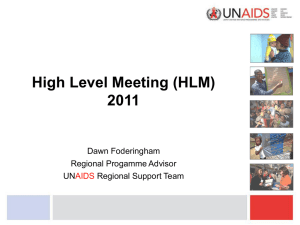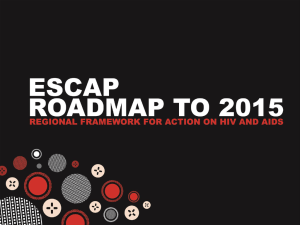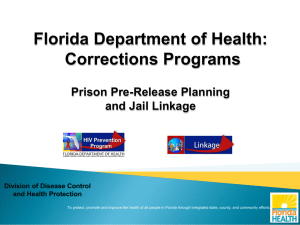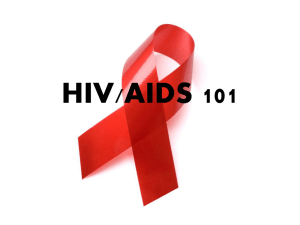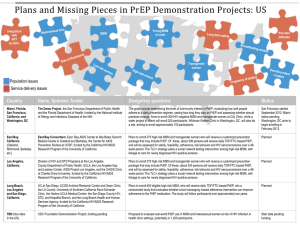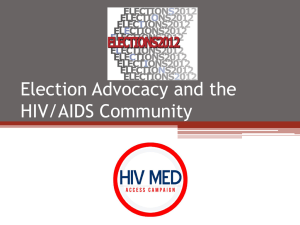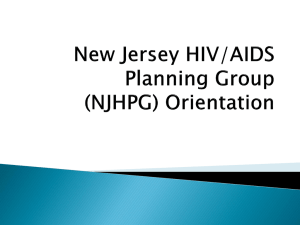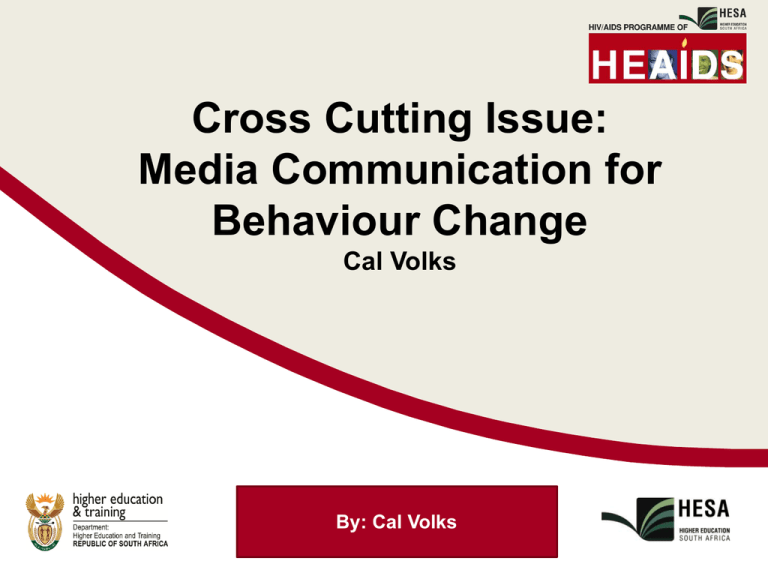
Cross Cutting Issue:
Media Communication for
Behaviour Change
Cal Volks
By: Cal Volks
Presentation Outline
• Recap what we mean HIV/AIDS Media Communication Campaigns
• Look at why Media Communication Campaigns they important at HEIs
and how we know that they work?
• What kinds of HIV/AIDS behavior messages at HEIs are relevant for
targeting with media communication in 2011?
• What are some examples of current creative HIV/AIDS media
communication campaigns that looked at addressing more complex
behavior change?
• Recommendations for Media Communication Campaigns in HEAIDS
phase 3
HIV/AIDS Communication campaigns
•Media Communication has been used in Health Promotion for many
years both in and outside HEI HIV/AIDS programmes
•Many theories. Entertainment-Education (Colle) approach made
famous by Johns Hopkins CCP:
“A strategic process is used to design and implement a media communication
message (incorporating participation from the target audience) with both
education and entertainment elements to facilitate social change”.
•The approach includes planning, persuasive communication
delivered in an entertaining way and feedback evaluation.
Colle RD. 2000. The Enter-Educate approach for promoting social change. The Journal of
Development Communication. Johns Hopkins University.
3
Why are HIV/AIDS Media Communication
Campaigns important at HEIs?
• Where HIV education workshops are voluntary, the students most
at risk may not self select to attend.
• There are often structural barriers at Universities that prevent
reaching all students through the academic curriculum (e.g. lack
of agreement that discipline specific HIV/AIDS education
SHOULD be in all disciplines)
• Participatory, Youth-culture friendly media communication and
events = often the only way to reach students
Why are some people ambivalent about using HIV/AIDS
media communication campaigns?
•In the past 2 decades, HIV/AIDS campaigns in South Africa particularly
those associated with high budgets and entertainment - a fair amount of
criticism. E.g. The Sarafina play and the Lovelife campaign
•An example of this criticism: from Warren Parker:
“The LoveLife intervention…
positioned South African youth – as fundamentally driven by internal values of materialist
consumption…. The notion of 12-17 year old South African youth as mono-cultural and
unified by sexual desire and materialist consumption, directly contradicted obvious
diversities of language, culture and access to disposable income amongst youth.”
Can’t do one size fits all.
•However other media communication campaigns have been successful
e.g. several orchestrated by the Treatment Action Campaign, formed in
2001
•Parker, Warren (2006). Claims and realities in programme evaluation: reflections on
LoveLife, South Africa. http://www.cadre.org.za/files/Parker%20Toronto%20THPE0580.pdf
How do we know HIV/AIDS Media Communication
Campaigns Can Work ?
•The 2010 document produced by HEAIDS for Higher Education,
Guidelines for effective HIV and AIDS Communication: Rules and tools for
Campus Programmes (P.3)
“ There is a fair amount of scepticism about the power of communication campaigns
to achieve behaviour change...but there is a whole body of research that shows that
behaviours promoted in South Africa’s best known HIV and AIDS campaigns are
being adopted by an increasing number of people, especially by teenagers and
young people in their early 20’s. The survey found that the campaigns had
statistically significant effects in the following areas: using a condom...;
discussing HIV testing with one’s sexual partner...; having ever had an HIV
test; Helping someone sick with AIDS; knowing about ARV treatment for AIDS;
having a positive attitude towards living with HIV and AIDS...”.
•More focussed evaluations by Soul City and Khomanani over a number of
years have established changes in knowledge, attitude and behaviour
that relate directly to the messaging of some of their recent
campaigns.
6
How do we know HIV/AIDS media
communication campaigns can work cont ?
In a YRBS conducted at UCT in 2009 (with results
generalisable to the UCT residence population)
•75% of the sample of respondents who had attended
HIV/AIDS awareness events thought that the
activities they had attended were “worth their
time”.
•72% thought that they learnt something new.
What do we already know about MCP
• We are competing with brand marketing for young people’s attention
so we need to be as good.
•
Use the fact that young people want to operate in a digital age (social
networking e.g. mix it, facebook, twitter and other online platforms).
E.g. Drive attention to a web site.
What kinds of HIV/AIDS behavior messages at
HEIs are relevant for targeting with Media
Communication in 2011?
Prevention Messages : Cannot just be saying Abstain, Be Faithful, Use a Condom
HEAIDS National Prevalence Survey (2010) tells us :
• “HIV prevention needs to depart from simple awareness campaigns, condom
provision and VCT provision”.
•
“It is well established in the literature that going through VCT has little influence on
HIV prevention among individuals who test negative. VCT should therefore be seen
as a supplementary strategy” ( Not the only prevention communication strategy).
•
“We need to develop strategies on each campus to reduce susceptibility to risk at a
systemic or environmental level”. Address the context in which HIV can spread –
e.g. look at alcohol use; gender dynamics; social identities that give rise to risky
behaviour
•
“ The HIV epidemic is heterogeneous within and between institutions”. A one
size fits all model will never be effective. We need to have a range of media
communication.
What do we mean by moving away from simple
communication messages?
Target Specific groups:
• Nat Prevalence Survey:
“Special efforts must be made
to ensure that female
students, older students and
male members – including
men who have sex with men –
in the campus community are
reached in HIV prevention
efforts.”
What do we mean by moving away from
simple media communication messages cont ?
E.g. Media and Events that communicate about
Intergenerational sex
Nat Prevalence Survey: “It is important to promote an
understanding among younger students and staff of the
higher risk of having older partners”.
Concurrent sexual partners
Nat Prevalence Survey : “Avoiding concurrent or overlapping sexual partnerships should be given much closer
attention in campus campaigns.
Need to be careful of language. Students may not call it Concurrent Sexual partners, but
overlapping or “having game”.
What kinds of HIV/AIDS behaviour messages at
HEIs are relevant for targeting with
Communication in 2011?
Support for PLWH/A and Anti HIV Stigma campaigns:
• You may not be aware that you have stigmatized HIV
positive people in the past, watch your language!
• It is up to all of us to build an HIV and AIDS stigma free
Higher Education community.
Examples of Prevention Campaigns from
SA Universities
Examples of Prevention Campaigns from SA Universities
Examples of Stigma Campaigns
from SA Universities
Bird Campaign
2006
“Can I tell
you?” 2007
16
How can we improve HIV/AIDS
Media Communication at HEIs ?
Veena Parboo Rawjee in her article HIV/AIDS Campaigns: Challenges At
Higher Education Institutions In South Africa (2010) recommends;
•Campaign objectives should be stated in measurable terms;
• Messages should be designed using theory and should follow from a needs
analysis
•Audience should be segmented (no one size fits all)
•Campaigns should be pre-tested with the target audiences before being
implemented ;
•Financial and organizational support at the highest levels must be sought to
ensure a critical mass of resources;
How can we improve HIV/AIDs Media
Communication at HEIs cont…?
•Multiple channels of communication should be used;
• Formal methods of evaluation should be conducted of the overall
campaign.
•Anecdotal evidence from programme managers tells us that staff
shortages, resource shortages and lack of training in campaign
design and specific campaign monitoring & evaluation prevent all
this from happening and yet if we put these pieces in place, e.g.
evaluate and document responses to media communication
camapigns, it might enable us to raise funds for our programmes
because we might be able to proove that we are effective
Recommendations
• We need to raise funds to implement planned, evaluated diversified and
targeted media communication for a variety of groups on a variety of
campuses.
• To resolve the best communication strategy between HEAIDS and HEIs
around encouraging resources for HIV/AIDS education such as media
communication. E.g. Is it from HEAIDS to the HEI executive (with the aim of getting them to
commit funds to HIV/AIDS incl. media communication) but which anecdotal evidence shows they just
forward to the IO who they tell to do all kinds of education on limited funds? Is it direct to the IO who then
“fight” with the exec for funds?
• Train HEI IOs to develop communication campaigns using research and
evaluation
• To have a data base where posters and event story boards that have
already been developed can be shared (provided credit is given).

